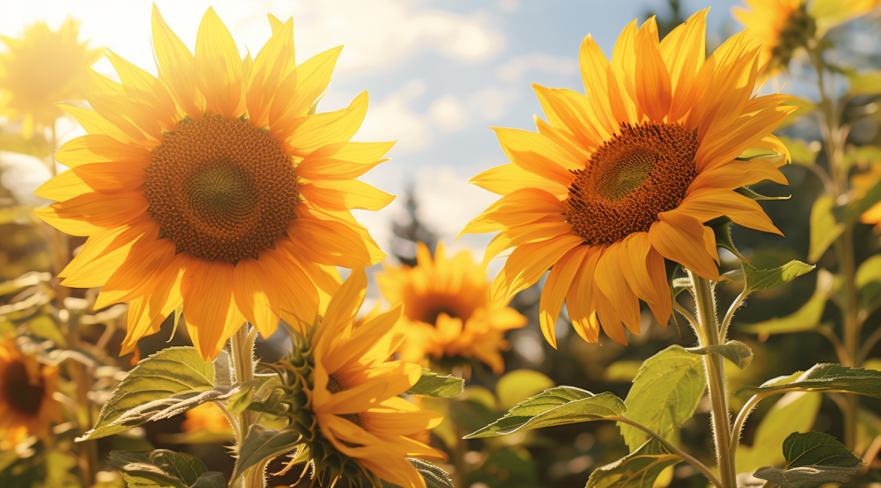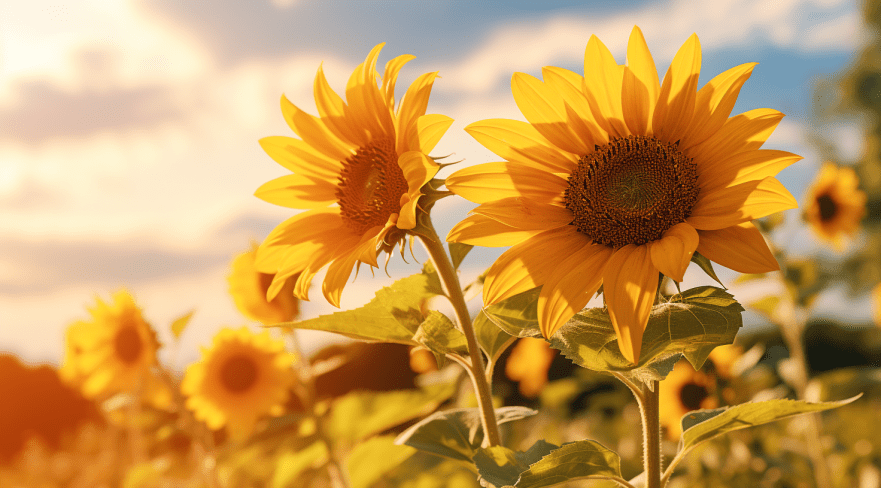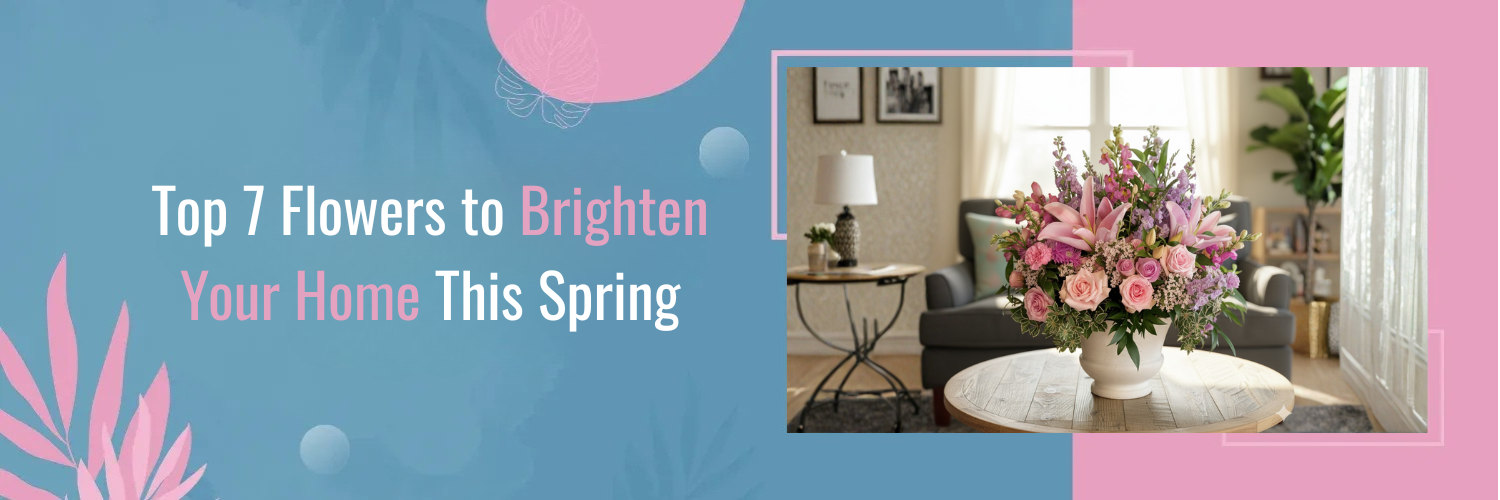Sunflower Care Throughout the Four Seasons
Taking Care of Sunflowers

Sunflowers are not just stunning additions to your garden; they are also versatile plants that can thrive throughout the year when cared for properly. In this blog, we will delve into the art of sunflower care and explore the importance of tending to these magnificent flowers in all four seasons. From spring planting to winter protection, we’ll cover it all to help you nurture your sunflowers to their full potential.
Throughout this blog, we’ll provide you with a comprehensive guide on sunflower care, ensuring that you have all the knowledge you need to maintain healthy and vibrant sunflowers in your garden.
Spring Sunflower Care
As the seasons shift from the chill of winter to the warmth of spring, it’s the perfect time to start thinking about planting sunflowers. Spring sunflower care is crucial to ensure these vibrant flowers thrive throughout the growing season. In this section, we will discuss the essential steps and considerations for caring for sunflowers during the spring months.
Preparing for Planting
Before you get your hands in the soil, some preparation is in order:
- Selecting the Right Location: Sunflowers are sun-loving plants. Choose a location that receives at least 6-8 hours of direct sunlight daily. Make sure the soil is well-drained to prevent waterlogging.
- Soil Testing: Start by testing your soil’s pH and nutrient levels. Sunflowers thrive in slightly acidic to neutral soil (pH 6.0 to 7.5). Soil testing kits are widely available and can provide valuable insights.
- Soil Preparation: Begin preparing your garden bed by removing any weeds or debris. Loosen the soil to a depth of about 12 inches using a shovel or garden fork. This helps sunflower roots penetrate the soil easily.
- Amend the Soil: Based on your soil test results, amend the soil with organic matter if necessary. Compost or well-rotted manure can improve soil fertility and structure.
Choosing the Right Varieties
Not all sunflowers are the same, and choosing the right variety is essential for a successful spring planting. Consider the following factors:
- Variety Height: Sunflowers come in various heights, from dwarf varieties to towering giants. Choose a variety that suits your garden’s size and aesthetic preferences.
- Bloom Size and Color: Sunflowers offer a range of bloom sizes and colours, from classic yellow to deep reds and oranges. Select the colours that resonate with your garden’s theme.
- Duration of Bloom: Some sunflower varieties bloom earlier than others. If you want a longer-lasting display, choose a mix of early and late-blooming varieties.
Planting Sunflower Seeds
Once you’ve prepared your garden bed and selected your sunflower varieties, it’s time to plant the seeds:
- Spacing: Sunflower seeds should be planted about 1 to 2 inches deep and spaced approximately 6 to 12 inches apart, depending on the variety’s size. Follow the specific spacing recommendations on the seed packet.
- Watering: After planting, thoroughly water the soil. Keep the soil consistently moist but not waterlogged until seedlings emerge. Once they are established, sunflowers are somewhat drought-tolerant.
- Timing: Spring is the ideal time for planting sunflowers after the last frost has passed. Consult your local frost dates to determine the best planting time for your region.
Soil Preparation and Fertilization
Healthy soil is the foundation for robust sunflower growth:
- Mulching: Apply a layer of organic mulch, such as straw or wood chips, around the base of your sunflowers. Mulch helps retain moisture, suppress weeds, and regulate soil temperature.
- Fertilization: Sunflowers are relatively light feeders, but they benefit from a balanced, all-purpose fertilizer. Apply fertilizer according to the package instructions, typically in early spring.
- Watering: Maintain consistent moisture levels by watering your sunflowers deeply when the soil starts to dry out. Morning watering is ideal to allow the plants to dry before evening.
Early-Season Care Tips
As your sunflower seedlings grow, there are a few additional care considerations:
- Thinning: If you’ve sown multiple seeds in one spot, thin the seedlings to the recommended spacing once they reach a few inches in height. This prevents overcrowding and ensures better air circulation.
- Weed Control: Regularly inspect your sunflower bed for weeds and remove them promptly to reduce competition for nutrients.
- Pest Prevention: Keep an eye out for early signs of pests and take action as needed. Handpick larger pests like caterpillars, and use organic solutions for smaller insects.
By following these spring sunflower care guidelines, you’ll set the stage for a beautiful and vibrant sunflower display as the warmer months progress. Stay tuned for our next section on summer sunflower care to continue nurturing your sunflowers through the growing season.
Summer Sunflower Care
Summer is the season when your sunflowers truly shine, reaching for the sky with their radiant blooms. Proper care during these warm months is essential to ensure your sunflowers continue to thrive and provide a stunning display. In this section, we’ll explore the key aspects of summer sunflower care.
Caring During the Summer Months
- Watering Requirements: Sunflowers have deep roots, so it’s crucial to water them deeply and infrequently. Water your sunflowers early in the morning to allow the soil to dry before evening, reducing the risk of fungal diseases. Aim to provide about 1 inch of water per week, adjusting for rainfall.
- Mulching: Maintain a layer of mulch around the base of your sunflowers. Mulch helps retain soil moisture, regulate soil temperature, and suppress weed growth. Refresh the mulch as needed throughout the summer.
- Weed Control: Regularly inspect your sunflower bed for weeds. Remove them promptly to reduce competition for nutrients, water, and sunlight.
- Deadheading: To encourage continuous blooming, deadhead (remove) spent flowers. Use clean scissors or pruning shears to cut the dead blooms just below the flower head. This prevents the plant from putting energy into seed production and encourages the growth of new blooms.
Protection from Pests and Diseases
- Pest Inspection: Keep a close eye on your sunflowers for signs of pests such as aphids, caterpillars, and sunflower moths. Handpick larger pests and consider using organic insecticidal soap or neem oil to deter smaller insects.
- Companion Planting: Planting companion flowers like marigolds, nasturtiums, and daisies near your sunflowers can help deter certain pests.
- Fungal Diseases: Be vigilant for fungal diseases like powdery mildew, which can affect sunflowers in humid conditions. To prevent fungal issues, water at the base of the plant rather than overhead, and ensure good air circulation by spacing your sunflowers adequately.
Supporting Tall Varieties
If you’ve planted tall sunflower varieties, it’s essential to provide proper support:
- Staking: Tall sunflowers may require staking to prevent them from toppling over in strong winds. Use bamboo stakes or other sturdy supports to prop them up.
- Tying: Gently tie the sunflower stems to the stakes using soft garden twine or plant ties. Be careful not to constrict the stem’s growth.
- Pruning Lateral Branches: To focus the plant’s energy on the main stem and flower development, consider removing some lateral branches. This can help reduce the weight on the main stem.
Harvesting Sunflower Seeds
While summer is all about the stunning blooms, it’s also an excellent time to think about harvesting seeds for future use or culinary endeavours:
- Optimal Time: Sunflower heads are ready for harvesting when the back of the flower head turns brown, and the seeds appear plump and mature. This usually occurs in late summer to early fall.
- Harvesting: Cut the sunflower heads with a few inches of stem attached using sharp pruners. Allow them to dry further in a warm, well-ventilated area before removing the seeds.
Enjoying the Beauty of Summer Sunflowers

Summer sunflowers are a sight to behold, their golden faces following the sun’s path across the sky, and their towering stems reaching for the heavens. Beyond their visual appeal, there are several ways to fully appreciate and enjoy the beauty of summer sunflowers in your garden:
Creating Visual Impact
- Sunflower Garden Design: Consider designing a dedicated sunflower garden or bed in your yard. Arrange sunflowers of different heights and varieties strategically to create an eye-catching display. Grouping them can amplify their impact.
- Colourful Companions: Pair sunflowers with other vibrant summer flowers like zinnias, cosmos, or dahlias. The contrasting colours and shapes can enhance the visual appeal of your garden.
- Cut Flower Bouquets : Bring the beauty of your sunflowers indoors by cutting a few blooms for fresh flower arrangements. They make stunning centrepieces that brighten up any room.
Encouraging Wildlife
- Attracting Pollinators: Sunflowers are a favourite of bees and butterflies. By growing sunflowers, you’re not only beautifying your garden but also providing essential food for these beneficial pollinators.
- Birdwatching: Sunflowers’ large seed heads attract birds, especially finches. Set up bird feeders or leave the dried sunflower heads in your garden during the fall and winter to attract a variety of feathered friends.
Creative Uses
- Photography: Capture the vibrant colours and intricate details of your sunflowers through photography. The striking contrast between the yellow petals and the blue sky can yield stunning images.
- Art and Crafts: Sunflower blooms and seeds can inspire creative projects. Paint, draw, or craft sunflower-themed art, or use the seeds for jewellery, bird feeders, or even homemade sunflower oil.
Fall Sunflower Care
As the summer season draws to a close and the weather begins to cool, it’s time to shift your focus to fall sunflower care. Fall marks a crucial phase in the sunflower lifecycle, as it’s the season for harvesting seeds and preparing your plants for the winter months. In this section, we’ll guide you through the essential steps for taking care of your sunflowers in the autumn.
Exploring the Optimal Time for Harvesting Sunflower Heads
Harvesting sunflower heads at the right time is crucial. You’ll know it’s time when the flower heads have matured, the petals have wilted, and the back of the flower head turns brown. This typically occurs in late summer to early fall, depending on your location and the specific sunflower variety.
- Cutting Technique: Use sharp pruners or garden shears to cut the sunflower heads, leaving a few inches of stem attached. Cut just below the flower head, where it meets the stem.
- Drying: After harvesting, allow the sunflower heads to continue drying in a warm, well-ventilated area. This helps ensure that the seeds inside are fully mature and dry.
Drying and Storing Sunflower Seeds
- Removing Seeds: Once the sunflower heads are sufficiently dry, rub or shake them gently to release the seeds. You can also use your fingers to separate the seeds from the flower head.
- Cleaning Seeds: Winnow the seeds to remove any remaining debris or plant material. You can do this by gently blowing on the seeds or using a fine sieve.
- Storage: Store your sunflower seeds in airtight containers or glass jars. Make sure the containers are completely dry before storing the seeds to prevent mould or moisture issues. Store them in a cool, dark place.
Utilizing Harvested Sunflower Seeds
- Culinary Delights: Sunflower seeds are not only a delicious and nutritious snack but can also be used in various culinary creations. Roast them with your favourite seasonings or use them in salads, granola, or as a topping for baked goods.
- Bird Feed: Consider leaving some dried sunflower heads in your garden as natural bird feeders. They attract birds like finches and provide a valuable food source during the colder months.
Preparing Sunflowers for Winter
- Pruning: Trim back the remaining foliage and stems of your sunflowers. This not only tidies up the garden but also reduces the risk of fungal diseases over the winter.
- Mulching: Apply a layer of mulch around the base of your sunflowers to protect the roots from freezing temperatures. Mulch also helps maintain a more consistent soil temperature.
- Frost Protection: Keep an eye on the weather forecast. If a sudden frost is expected, consider covering your sunflowers with frost blankets or burlap sacks to shield them from the cold.
- Planning for Spring: While caring for your sunflowers in the fall, take some time to plan for the next growing season. Consider rotating your crops if you’re planting sunflowers in the same spot next year, and think about any adjustments to soil preparation or care techniques.
By following these fall sunflower care guidelines, you can maximize the benefits of your sunflower crop, from enjoying delicious seeds to providing sustenance for local wildlife. Additionally, proper care now sets the stage for a successful sunflower garden when spring returns.
Winter Sunflower Care
Winter is a challenging season for sunflowers, as they are not frost-tolerant and need protection from harsh weather conditions. Proper winter care ensures the health and longevity of your sunflowers, allowing them to return in full glory when spring arrives. In this section, we’ll explore essential steps to protect your sunflowers during the winter months.
Providing Winter Protection
- Mulching: Applying a thick layer of mulch around the base of your sunflowers in late fall can insulate the soil and protect the roots from freezing temperatures. Use materials like straw, leaves, or wood chips.
- Wrapping: For taller sunflower varieties, consider wrapping the stems with burlap or frost cloth to protect them from frost and cold winds. This can help prevent the stems from snapping or becoming damaged during winter storms.
- Insulating the Roots: If you live in an area with severe winters, insulate the root zone further by piling additional mulch or straw over the base of the plants.
- Snow Cover: In regions with consistent snowfall, snow can serve as a natural insulator. Leave a layer of snow on your sunflower bed to provide protection, but be cautious not to let the snow pile too high and damage the plants.
Preventing Frost Damage
- Frost Cloth: Cover your sunflowers with frost cloth or blankets on particularly cold nights when frost is expected. Secure the cloth to prevent it from blowing away and remove it during the day to allow sunlight and air circulation.
- Watering Strategy: Be mindful of watering during the winter. Water your sunflowers sparingly, as wet soil can freeze and potentially harm the roots. Water early in the day so the soil has time to dry before evening.
Pruning and Cutting Back
- Pruning: Inspect your sunflowers for any dead or damaged foliage. Prune away any affected leaves or stems to prevent the spread of disease and encourage healthy regrowth in the spring.
- Cutting Back: In late winter or early spring, once the risk of frost has passed, you can cut back the dead stems to about 6 inches above ground level. This promotes new growth and prepares your sunflowers for the upcoming growing season.
Planning for the Next Growing Season
- Soil Preparation: Use the winter months to plan for the next growing season. Test your soil to assess its fertility and pH levels. Amend the soil with organic matter and nutrients as needed to prepare it for planting.
- Variety Selection: Choose your sunflower varieties for the next season and order seeds well in advance. Consider adding new and exciting varieties to your garden for a diverse display.
- Garden Rotation: If you’re practising crop rotation, plan the layout of your garden to ensure that sunflowers are in a different location from where they were planted the previous year. This helps prevent soil depletion and disease buildup.
- Garden Cleanup: Continue to keep your garden bed free of debris and weeds during the winter months to reduce the risk of pests and diseases.
By providing winter protection, preventing frost damage, and planning for the next growing season, you can ensure that your sunflowers survive the winter and thrive when spring arrives. With proper care and attention, your sunflower garden will continue to bring beauty and joy year after year.
Conclusion

In the journey of sunflower care, each season brings its unique joys and responsibilities. From the vibrant blooms of summer to the cozy preparations of winter, tending to your sunflowers throughout the year is a rewarding endeavour. As you nurture these majestic flowers, you not only cultivate their beauty but also contribute to a healthier garden ecosystem.
And if you’re looking to share some flower arrangements with someone special, why not consider ordering a bouquet from Bourkes Florist ? Our expertly crafted arrangements can bring the beauty of right to your doorstep. Order now.
FAQs
Q: Can sunflowers survive in cold climates during the winter?
Sunflowers are not frost-tolerant, so in cold climates, it’s essential to provide winter protection. You can insulate the soil with mulch, wrap the stems with frost cloth, and take measures to prevent frost damage.
Q: When is the best time to plant sunflowers in the spring?
The best time to plant sunflowers in the spring is after the last frost has passed. Consult your local frost dates to determine the optimal planting time for your region.
Q: How do I prevent common sunflower pests in my garden?
Preventing common sunflower pests involves maintaining good garden hygiene, using organic pest control methods like neem oil, and implementing companion planting with pest-repelling flowers.
Q: Can I save sunflower seeds for planting next year?
Yes, you can save sunflower seeds for planting next year. Harvest mature seeds, dry them thoroughly, and store them in a cool, dry place in airtight containers.
Q: What sunflower varieties are best for small gardens or containers?
Dwarf sunflower varieties, such as the Sunflower ‘Music Box’ or ‘Sundance Kid,’ are ideal for small gardens or containers due to their compact size and manageable growth.
Q: Do sunflowers need a lot of water during the summer months?
While sunflowers are somewhat drought-tolerant, they still need consistent moisture during the summer months, especially when they are establishing roots and blooming. Deep, infrequent watering is generally recommended.

























